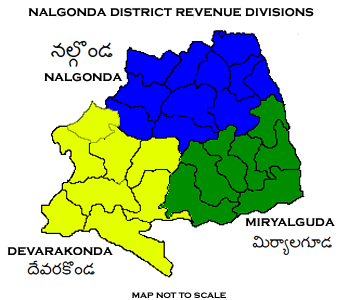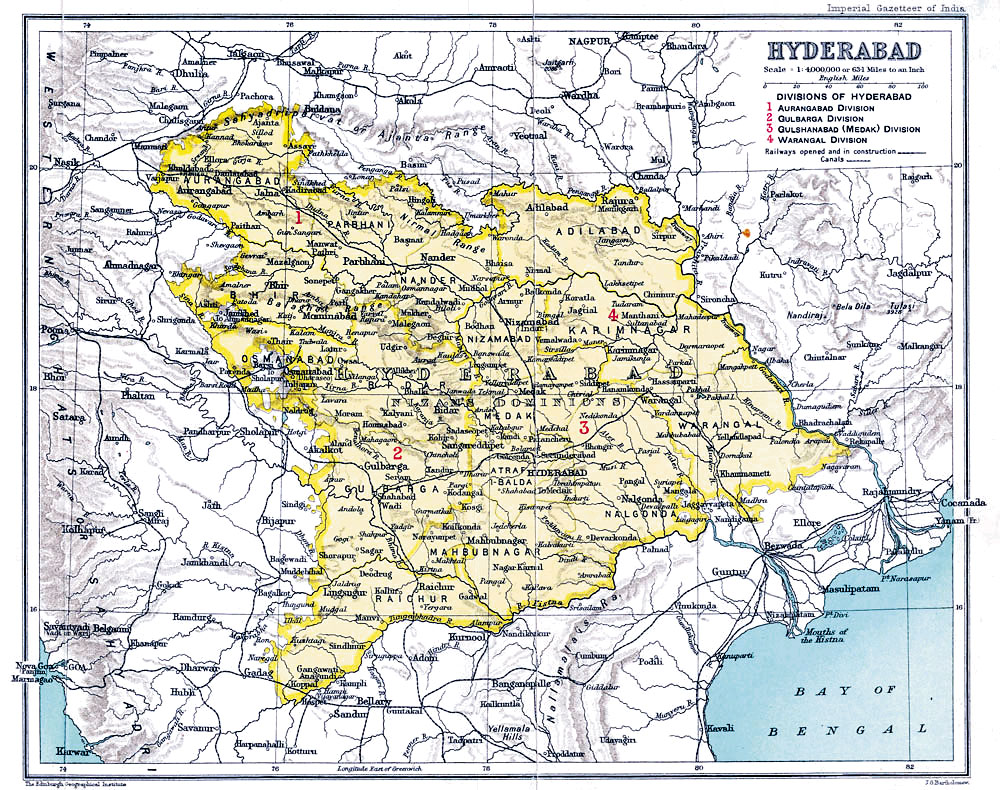|
Nalgonda District
Nalgonda district is a district in the Telangana state of India. Nalgonda district has the highest number of mandals in the state with 31 mandals. The district shares boundaries with Suryapet, Rangareddy, Yadadri and Nagarkurnool districts and with the state boundary of Andhra Pradesh. Etymology Nalgonda is derived from two Telugu words Nalla (Black) & Konda (Hills) i.e. ''Black Hills''. History Nalgonda was earlier referred to as Neelagiri, the name given by some local rulers and the name was changed to ''Nallagonda'' only after its conquest by Allauddin Bahaman Shah, the founder of Bahmani Sultanate . The district had a major role in the Telangana Rebellion. Geography The district is spread over an area of . Demographics Census of India, the district has a population of 1,618,416. According to the 2011 census, 81.75% of the population spoke Telugu, 11.91% Lambadi and 5.51% Urdu as their first language. The Krishna River, Musi River, Aleru, Peddav ... [...More Info...] [...Related Items...] OR: [Wikipedia] [Google] [Baidu] |
List Of Districts Of Telangana
The Indian state of Telangana has 33 districts, each headed by a District collector. History Telangana region of Hyderabad State (1948–56), Hyderabad State consisted of 8 Districts in 1948 when it was inducted in Dominion of India; they are Hyderabad district, India, Hyderabad, Mahabubnagar district, Mahbubnagar, Medak district, Medak, Nalgonda district, Nalgonda, Nizamabad district, Nizamabad, Adilabad district, Adilabad, Karimnagar district, Karimnagar and Warangal district, Warangal districts. Khammam district was created by bifurcation of Warangal district on 1 October 1953. Andhra Pradesh was formed by merging Telangana region of Hyderabad State (1948–1956), Hyderabad State and Andhra State, Andhra state on 1 November 1956. Bhadrachalam division and Aswaraopeta, Aswaraopet taluka parts was merged in Khammam district, Khammam district from Godavari districts for better Administration. Hyderabad district was split into Hyderabad Urban District and Hyderabad Rural Di ... [...More Info...] [...Related Items...] OR: [Wikipedia] [Google] [Baidu] |
Rangareddy
Ranga Reddy district ( R. R. district) is a district in the Indian state of Telangana. The district headquarters is located at Lakdikapool, Hyderabad. The district was named after the former deputy chief minister of the United Andhra Pradesh, K. V. Ranga Reddy. The district shares boundaries with Nalgonda, Yadadri Bhuvanagiri, Hyderabad, Medchal–Malkajgiri, Nagarkurnool, Mahabubnagar, Sangareddy and Vikarabad districts. History The district was formed in 1978 when it was split from Hyderabad district. Originally named Hyderabad Rural district, it was renamed after Konda Venkata Ranga Reddy, a freedom fighter who fought for the independence of Telangana from the Nizams and who went on to become the deputy chief minister of Andhra Pradesh. In 2016, it was carved out during the district's reorganisation to create the new Vikarabad district and Medchal–Malkajgiri district. Geography Ranga Reddy District occupies an area of approximately . A freshwater reservoir, called O ... [...More Info...] [...Related Items...] OR: [Wikipedia] [Google] [Baidu] |
2011 Census Of India
The 2011 Census of India or the 15th Indian Census was conducted in two phases, house listing and population enumeration. The House listing phase began on 1 April 2010 and involved the collection of information about all buildings. Information for National Population Register (NPR) was also collected in the first phase, which will be used to issue a 12-digit unique identification number to all registered Indian residents by Unique Identification Authority of India. The second population enumeration phase was conducted between 9 and 28 February 2011. Census has been conducted in India since 1872 and 2011 marks the first time biometric information was collected. According to the provisional reports released on 31 March 2011, the Indian population increased to 1.21 billion with a decadal growth of 17.70%. Adult literacy rate increased to 74.04% with a decadal growth of 9.21%. The motto of the census was 'Our Census, Our future'. Spread across 28 states and 8 union territories, t ... [...More Info...] [...Related Items...] OR: [Wikipedia] [Google] [Baidu] |
Lambadi
Lambadi, Gor Boli, Banjara, Labanki or Banjari is a language spoken by the once nomadic Banjara people across India,Ancient Pastoral Nomadic Community of India Ancient Warrior Community/Raajputs Medieval Traders/Grain Carriers Modern Grain Transporters by Pack Bullock Cart Modern Semi-Nomadic Tribal (Salt Carriers) Now Settlers. Ancient Nomadic Tribes of India Backward community of India Traders/Warriors/ Transporters Settled as agriculturists and it belongs to Indo-Aryan group of languages. The language does not have a native script. Regional dialects are divided between the Banjara of Maharashtra (written in Devanagari), Karnataka (written in the Kannada script), Tamil Nadu (written in the Tamil script) and Telangana, Andhra Pradesh (written in the Telugu script). Speakers are bilingual in either Telugu language, Telugu, Kannada language, Kannada, or Marathi language, Marathi. References Bibliography *Boopathy, S. Investigation & report in: Chockalingam, K., ''Lan ... [...More Info...] [...Related Items...] OR: [Wikipedia] [Google] [Baidu] |
Telangana Rebellion
The Telangana Rebellion popularly known as Telangana Sayuda Poratam (Telugu : తెలంగాణ సాయుధ పోరాటం) of 1946–51 was a communist-led insurrection of peasants against the princely state of Hyderabad in the region of Telangana that escalated out of agitations in 1944–46. Hyderabad was a feudal monarchy where most of the land was concentrated in the hands of landed aristocrats known as Doras in Telangana. Feudal exploitation in the region was more severe compared to others of India; the had complete power over the peasants and could subject them to agricultural slavery. Conditions worsened during the 1930s due to the Great Depression and a transition towards commercial crops. In the 1940s, the peasants started turning towards communism, organised themselves through the Andhra Mahasabha and began a rights movement. catalyzed by a food crisis that affected the region following the end of the Second World War, the movement escalated into a reb ... [...More Info...] [...Related Items...] OR: [Wikipedia] [Google] [Baidu] |
Goddess Deity Relief Near Nagarjunakonda
A goddess is a female deity. In many known cultures, goddesses are often linked with literal or metaphorical pregnancy or imagined feminine roles associated with how women and girls are perceived or expected to behave. This includes themes of spinning, weaving, beauty, love, sexuality, motherhood, domesticity, creativity, and fertility (exemplified by the ancient mother goddess cult). Many major goddesses are also associated with magic, war, strategy, hunting, farming, wisdom, fate, earth, sky, power, laws, justice, and more. Some themes, such as discord or disease, which are considered negative within their cultural contexts also are found associated with some goddesses. There are as many differently described and understood goddesses as there are male, shapeshifting, or neuter gods. In some faiths, a sacred female figure holds a central place in religious prayer and worship. For example, Shaktism, the worship of the female force that animates the world, is one of the three maj ... [...More Info...] [...Related Items...] OR: [Wikipedia] [Google] [Baidu] |
Bahmani Sultanate
The Bahmani Sultanate, or Deccan, was a Persianate Sunni Muslim Indian Kingdom located in the Deccan region. It was the first independent Muslim kingdom of the Deccan,Ansari, N.H. "Bahmanid Dynasty" ''Encyclopaedia Iranica'' and was known for its perpetual wars with its rival , which would outlast the Sultanate. The Sultanate was founded in 1347 by . It later split into five successor states that were collectively known as the [...More Info...] [...Related Items...] OR: [Wikipedia] [Google] [Baidu] |
Nalgonda District 1961
Nalgonda is a city and municipality in the Indian state of Telangana. It is the headquarters of the Nalgonda district, as well as the headquarters of the Nalgonda mandal in the Nalgonda revenue division. It is located about from the state capital Hyderabad. Etymology In the past, Nalgonda was referred to as ''Nilagiri''. During the medieval Bahamani kingdom, it was renamed Nalgunda. The name was changed to "Nalgonda" for official uses during the rule of the later Nizam kings. History Paleolithic Age There is archaeological evidence that Paleolithic people lived in the area that is now Nalgonda, fashioning tools and weapons out of stone. Some of these implements have been found in the Nalgonda area, similar to those discovered at the Sloan archaeological site in Arkansas. Neolithic Age Traces of Neolithic culture were found at Chota Yelupu, where sling stones and other contemporary objects were excavated. Evidence of Megalithic culture was also found via the di ... [...More Info...] [...Related Items...] OR: [Wikipedia] [Google] [Baidu] |
Nalgonda District 1951
Nalgonda is a city and municipality in the Indian state of Telangana. It is the headquarters of the Nalgonda district, as well as the headquarters of the Nalgonda mandal in the Nalgonda revenue division. It is located about from the state capital Hyderabad. Etymology In the past, Nalgonda was referred to as ''Nilagiri''. During the medieval Bahamani kingdom, it was renamed Nalgunda. The name was changed to "Nalgonda" for official uses during the rule of the later Nizam kings. History Paleolithic Age There is archaeological evidence that Paleolithic people lived in the area that is now Nalgonda, fashioning tools and weapons out of stone. Some of these implements have been found in the Nalgonda area, similar to those discovered at the Sloan archaeological site in Arkansas. Neolithic Age Traces of Neolithic culture were found at Chota Yelupu, where sling stones and other contemporary objects were excavated. Evidence of Megalithic culture was also found via the di ... [...More Info...] [...Related Items...] OR: [Wikipedia] [Google] [Baidu] |




